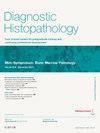一个有趣的反极性乳腺高细胞癌病例
引用次数: 0
摘要
我们报告了一例罕见的反极性乳腺高细胞癌(TCCRP)病例,患者是一名新发现乳房肿块的女性。TCCRP是乳腺乳头状癌的一种罕见亚型,其外观与甲状腺高细胞乳头状癌相似。TCCRP是一种病理生理学尚不清楚的罕见肿瘤,但最常见于绝经后妇女。它通常表现为三阴性表型。由于其罕见性以及与其他预后较差的乳腺良性和恶性病变的相似性,TCCRP的诊断可能会面临挑战。本文章由计算机程序翻译,如有差异,请以英文原文为准。
An interesting case of tall cell carcinoma of the breast with reverse polarity
We report a rare case of tall cell carcinoma of the breast with reverse polarity (TCCRP) in a woman who presented with a newly found breast lump. TCCRP is a rare subtype of papillary breast carcinoma that has similar appearance to tall cell papillary thyroid carcinoma. TCCRP is a rare tumour with unclear pathophysiology but is most frequently seen in postmenopausal women. It typically presents with triple negative phenotype. Diagnosing TCCRP can present diagnostic challenges due to its rarity and resemblance to other benign and malignant lesions of the breast with worse prognosis.
求助全文
通过发布文献求助,成功后即可免费获取论文全文。
去求助
来源期刊

Diagnostic Histopathology
Medicine-Pathology and Forensic Medicine
CiteScore
1.30
自引率
0.00%
发文量
64
期刊介绍:
This monthly review journal aims to provide the practising diagnostic pathologist and trainee pathologist with up-to-date reviews on histopathology and cytology and related technical advances. Each issue contains invited articles on a variety of topics from experts in the field and includes a mini-symposium exploring one subject in greater depth. Articles consist of system-based, disease-based reviews and advances in technology. They update the readers on day-to-day diagnostic work and keep them informed of important new developments. An additional feature is the short section devoted to hypotheses; these have been refereed. There is also a correspondence section.
 求助内容:
求助内容: 应助结果提醒方式:
应助结果提醒方式:


